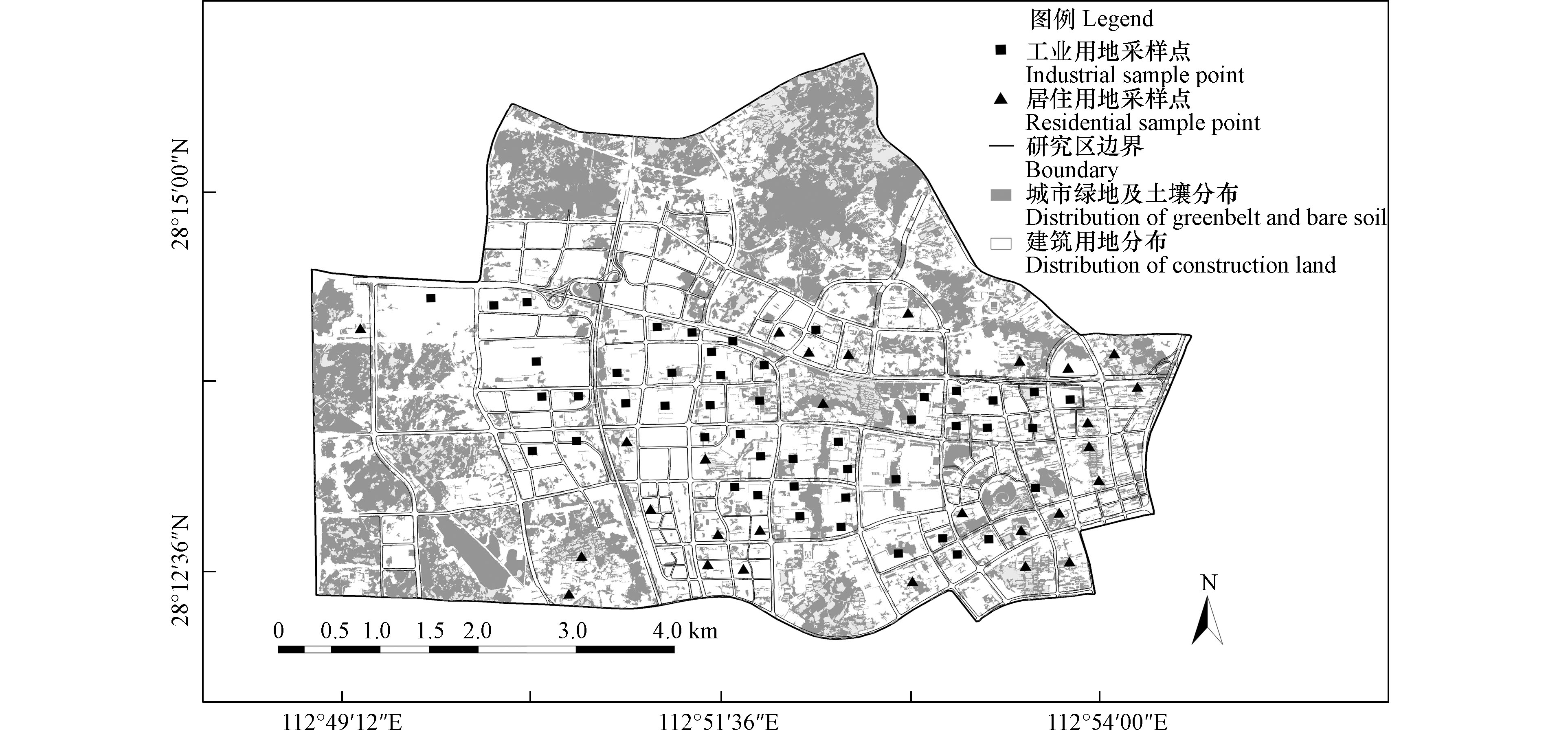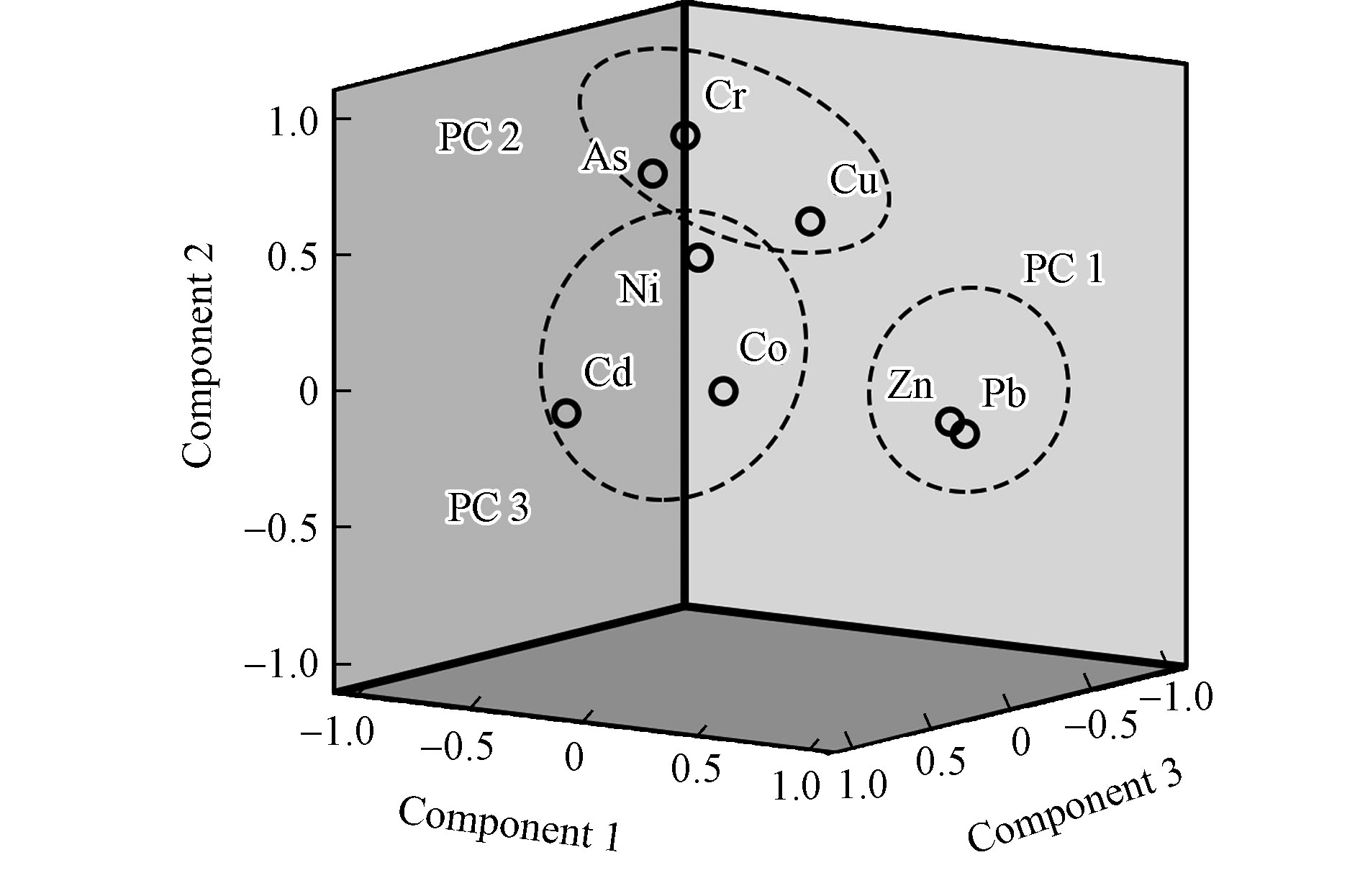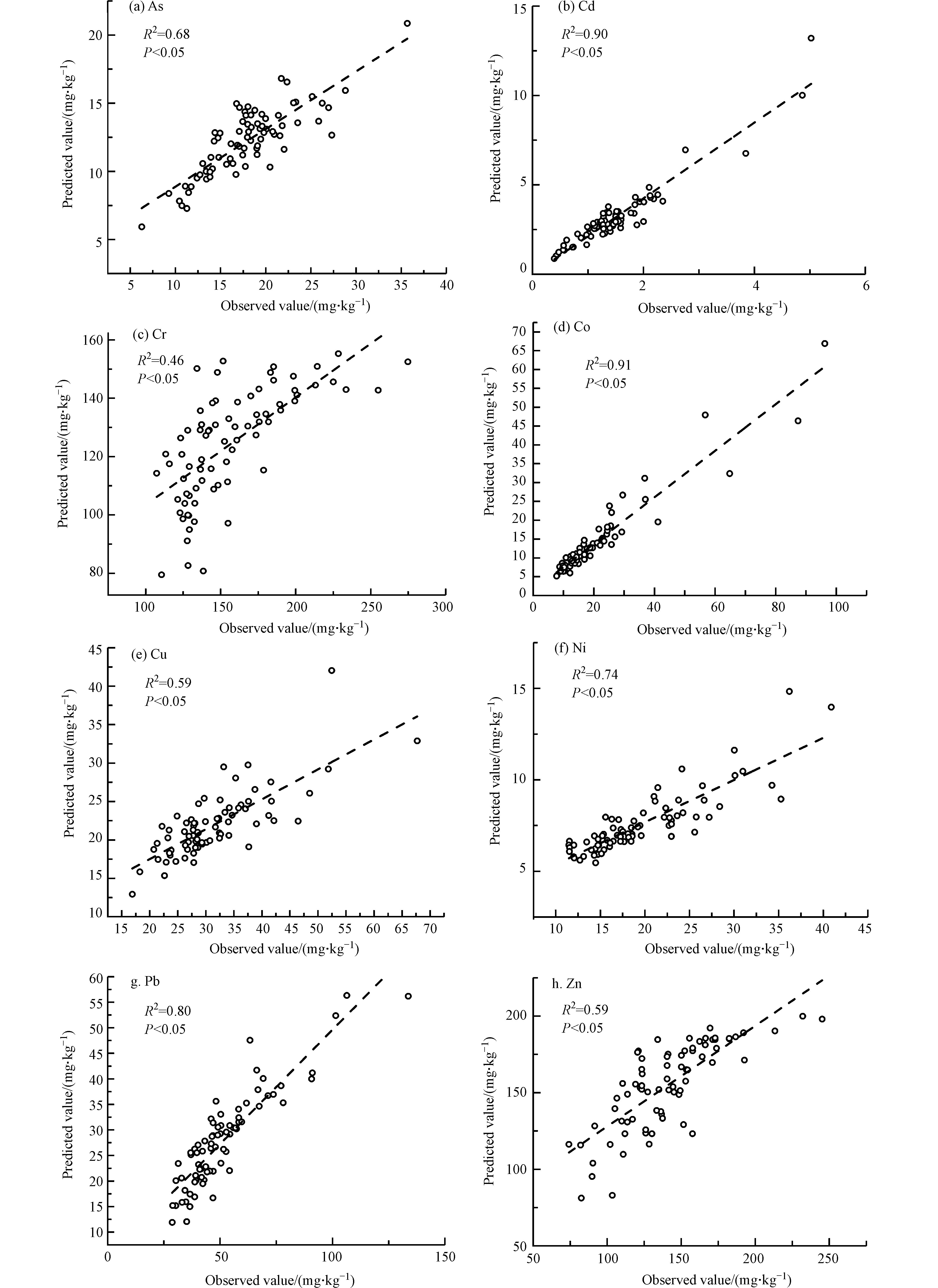-
随着我国快速城市化的进程,由人类活动导致的城市土壤重金属污染对人类自身健康所造成的威胁,愈发的引起了人们的关注[1-2]。对我国城市土壤而言,由工矿企业、生活垃圾以及交通活动所排放的重金属污染物在土壤中长期累积,已经对我国部分城市的人类健康造成危害[3-4]。高新技术工业普遍被认为污染物排放较少,但长期与工作场地的接触是否会导致产业工人存在显著的健康风险,在不同类型工业企业中工作的产业工人所受的风险是否存在差异,这些问题值得进行研究。同时,在位于城市边缘地区的高新技术工业开发区中工作的产业工人所接触到的土壤重金属污染物,是否主要来源于工业活动亦值得进行探讨。这一系列结果将有助于为产业工人提供科学的安全防护信息,为当地的重金属污染治理提供线索。
目前,土壤重金属污染的评价方法中,潜在生态风险评价法、人类健康风险评价法以及内梅罗污染指数法,在实践中得到了广泛的应用,能够较为科学的从生态风险、健康风险以及污染水平几个方面对土壤重金属污染物所造成的风险进行综合评价[5-8]。在相关研究中土壤重金属污染物的来源则是另一个受到重点关注的问题,主成分分析法、PMF法等在研究这一问题上得到了较好的应用[9-10]。在以往的研究中,李有文等在我国西北工业城市所开展的研究表明,工矿企业、交通活动对土壤重金属污染贡献较为突出,且工业区与生活区中人类健康风险明显高于其他功能区[11]。一项针对煤矿能源开发区的研究指出,煤矿与运煤公路是重金属污染物的监管重点,建议减少人类在这类污染环境中的暴露时间[12]。Zhuo等测定了山东省内15个开发区中多种土壤重金属污染物含量,结果表明,这些开发区中的居民均存在显著的致癌或非致癌健康风险,且19%的监测点存在中等水平的生态风险[13]。开发区作为城市周边最年轻的建设用地,往往聚集了大量产业工人在这里生活和工作,同时,高新技术开发区的污染程度、健康风险是否与上述开发区相似,高新技术工业是否等同于低污染工业,同样值得关注。
以往的研究普遍关注于由土壤重金属污染物所造成的成人与儿童的健康风险,以城市为对象的研究表明儿童的致癌和非致癌风险要比成人更为明显[14-15]。但对城市中特定人群在特定场地中的健康风险评价,除以幼儿园等为对象的研究外,则较少有关注[16]。长沙国家高新技术产业开发区作为我国中部地区重要的经济引擎以及高新技术立区的代表之一,集中了大量的产业工人,而我国劳动法的相关规定决定了工人的主要活动和停留场所并非工业场所而是居住场所,因此,根据活动时间,分场地计算健康风险将更加合理。
本文基于主成分/绝对主成分模型解析污染物来源,并定量地分析各污染源对重金属污染物的贡献,这些结果能够为具有相同或相似工业结构的高新技术工业开发区提供重金属污染物的治理依据,并向在开发区人口结构中占重要地位的产业工人提供及时的风险提示。
-
长沙国家高新技术产业开发区位于长沙市西部(东经112°48'36"—112°54'36",北纬28°11'24"—28°15'36"),是中国中部地区综合实力第二的国家级高新区,规划面积140平方公里下辖麓谷、雷锋、东方红、白马等4个街道办事处。2015年,建成区面积约50平方公里,常驻人口20万。本文研究范围以已建成区域及其周边总计49.28平方公里的居住和工业用地为主。研究区的区位如图1。其中,工业用地按照主要产品分为通用设备制造工业(GEI)、电子电器制造工业(EI)、金属及金属新材料制造工业(MPI)、生物医药工业(PMI)、混合工业(MI),各有14、5、6、5和18个样点,居住用地(RL)有28个样点。研究区内6车道及以上道路79.20 km(其中高速公路9.1 km),平均车流量、拥堵程度与市区相近。
-
采样时间:2018年9月,持续12 d没有降水后,采集76个样点的表层土壤样品。
布点与采样原则:以工业企业为基本单位,在各企业的道路网格内以边长约100 m的五点取样法进行取样,采集约500 g土壤样品剔除较大石块和根系等明显碎片后装入聚乙烯自封袋中,采样点分布如图1。
样品带回实验室后置于避光、干燥的实验室中敞口干燥10 d,隔袋反复碾压至无土块后分别过30目和100目筛,重新装袋储存。用万分之一天平称取0.2 g左右土样并记录,置入聚四氟乙烯消解罐中,随后依次加入5 mL 浓HNO3和5 mL 浓HCl,混匀后静置,直至无明显反应后加入5 mL HF溶解硅酸盐等难溶物,达到彻底溶解样品的目的。随后加盖密封,使用微波消解仪(CEM,Mars5)进行消解,消解温度190 ℃,消解过程总计45 min。为消解黑色沉淀再加入3 mL HCLO4振荡。溶液倒出后,聚四氟乙烯消解罐中的剩余溶液用5 mL 2%的稀HNO3冲洗3次,后用2%的稀HNO3定容至50 mL(所用药品均为分析纯)。在进行上述工作的同时,每一批微波消解的土壤样品中加入3份空白对照以及1份标准样品(GBW07429)。
Cr、Cu、Co、Ni、Pb、Zn元素分析采用电感耦合等离子体原子发射光谱仪ICP-OES(PerkinElmer, Optima 7300V);As和Cd元素的分析采用电感耦合等离子体质谱仪ICP-MS(Agilent,7700x)进行分析。Cr、Cu、Co、Ni、Pb、Zn的RSD在0.79%至5.63%的范围内,回收率为87%至106%。而As和Cd的RSD均低于5%,回收率分别为85.69%和92.30%。
-
瑞典学者Hakanson于1980年提出了潜在生态风险的评估方法。近年来,该方法广泛应用于评价土壤环境中重金属污染物所带来的潜在生态风险[17-18]。潜在生态风险指数(RI)由各个元素的潜在生态风险系数(Ej)计算而来。参考值为湖南省土壤重金属背景值[19-20]。其中各个元素的毒性系数分别为Cd=30, As=10, Cu=Ni=Pb=Co=5, Cr=2, Zn=1,并根据Men等的方法计算[21]。污染程度的划分标准如表1所示。
-
人类健康风险评价包括致癌风险和非致癌风险两个部分,本文运用美国环保署(US EPA)发布的健康风险评价模型进行评价。人类暴露在土壤重金属中的主要途径有3种,分别是摄取、吸入、接触。本文分别计算了产业工人在3种暴露途径的致癌、非致癌日均暴露量(ADD),并计算致癌风险与非致癌风险,采用Gao等的计算方法计算[22]。健康风险的计算参数来源于US EPA参考数据、《污染场地风险评估技术导则》、《中华人民共和国劳动法》以及我国近年发布的各项统计报告等,详见表2。为了充分研究产业工人的健康风险,本研究将其健康风险分为工作期间和居住期间两个部分进行评价。
人类在3种途径下的日均暴露量的计算公式如式1—3所示。
式中,
$ {{\rm{A}}{\rm{D}}{\rm{D}}}_{\text{摄入}} $ 、$ {{\rm{A}}{\rm{D}}{\rm{D}}}_{\text{吸入}} $ 和$ {{\rm{A}}{\rm{D}}{\rm{D}}}_{\text{接触}} $ 分别代表人类通过摄入、吸入和接触途径的重金属日均暴露量($ {\rm{k}}{\rm{g}} \cdot {{\rm{d}}}^{-1} $ );$ c $ 为土壤中重金属污染物含量($ {\rm{m}}{\rm{g}} \cdot {{\rm{k}}{\rm{g}}}^{-1} $ );其他项目如表2所示,其中EF是根据《国务院关于职工工作时间的规定》、《全国年节及纪念日放假办法》的相关规定,统计从2018—2020年间实际工作时间计算而来,3年年均工作日为245$ {\rm{d}} \cdot {{\rm{a}}}^{-1} $ ,且《中华人民共和国劳动法》规定产业工人周工作时间不得超过40 h。AT、BW根据《中国居民营养与慢性病状况报告(2015年)》和《长沙市第六次全国人口普查主要数据公报》由性别比例换算而来。R吸入、R摄取和ED数据来源于《污染场地风险评估技术导则(HJ 25.3-2014)》,表中其他数据均参考USEPA《暴露因子手册1997》。此外,除Co元素的SF值来源于杨刚等的研究[23],RfD和SF均来自于USEPA的参考数据(表3)。根据日均暴露量的结果,土壤重金属的非致癌和致癌风险的评价公式如式4-7所示。
式中,
$ {{\rm{H}}{\rm{Q}}}_{i} $ 为非致癌重金属i的健康风险指数;$ {{\rm{A}}{\rm{D}}{\rm{D}}}_{ij} $ 为重金属元素i在j暴露途径下的日均暴露量;$ {{\rm{R}}{\rm{f}}{\rm{D}}}_{ij} $ 重金属i在j途径下的参考剂量;$ {\rm{H}}{\rm{I}} $ 为所有8种重金属元素的非致癌风险;$ {{\rm{C}}{\rm{R}}}_{i} $ 为重金属元素i健康风险指数;$ {{\rm{S}}{\rm{F}}}_{ij} $ 为重金属i在j途径下的致癌健康风险的斜率系数;$ {\rm{C}}{\rm{R}} $ 为6种重金属元素(As、Cd、Cr、Co、Ni和Pb)的总致癌风险。当非致癌风险(HI)小于1时,表示非致癌健康风险处在可接受的范围内,当大于1时,则表明存在不可接受的非致癌风险。就致癌风险(CR)而言,除US EPA推荐的当结果为10−6时应为致癌风险开展治理外,也有学者认为结果在10−6—10−4之间时也是可以接受的[24-25]。 -
主成分分析、单因素方差分析以及APCS-MLR受体模型分析均由SPSS 19.0实现;表的制作由Excel 2016完成,图由Arcgis 10.2和Origin 2017绘制。
-
工业用地与居住用地是产业工人活动的主要区域,表4表明工业用地中除Ni为当地土壤背景值的70%外,As、Cd、Cr、Co、Cu、Pb、Zn分别超过当地土壤背景值的1.25、13.13、2.39、1.62、1.22、1.65、1.44倍,居住区中As、Co、Ni低于背景值。工业用地中8种土壤重金属污染物的变异系数普遍高于居住区的1.5倍以上,其中Cd、Co、Cu、Ni分别高达2.29、2.52、2.07、2.07倍。此外,工业用地中Cd和Co的变异系数分别达到了56.60%和77.26%。单因子污染指数的结果表明,Cd元素对当地土壤污染的贡献显著高于其他元素,其他7种元素在工业区中的单因子污染指数则分布在0.70至2.39的区间,而在居住区中则分布在0.47至1.89的范围内,内梅罗污染指数的结果表明无论是工业区还是居住区均存在强污染风险(PN>3)。
表5进一步探讨了不同工业及居住用地间的污染物浓度差异,表明Pb在各类工业区以及居住区间的浓度差异并不显著,除Pb、Zn外,其他6种元素的显著低值均在居住区中得以发现。表明工业活动对该高新区中土壤污染分布的影响是显著的,也是当地土壤重金属污染的主要来源,应予以关注。As、Cr、Co、Cu的显著高值则均集中在GEI用地中,暗示这些元素在土壤中的累积可能与该类型的工业活动存在关联,亦说明GEI工业对土壤重金属污染物种类的贡献较其他类型工业活动而言更为综合,表明应关注在该类工业企业中工作的产业工人的健康状况。EI工业中Cd、Cr、Co、Ni、Pb、Zn的平均含量均普遍低于其他工业,其中Cd元素差异最为明显,且低于居住用地,表明土壤中Cd污染与EI工业之间的关系弱,而该元素在其他4类工业中的高值表明其与工业活动的关系紧密,这一结果为该元素的精准防治工作提供了方向。
-
相关性分析的结果表明,As—Cr、Cd—Co、Cd—Ni、Cr—Cu、Cr—Ni、Co—Cu、Co—Ni、Co—Zn、Cu—Ni、Cu—Zn、Pb—Zn之间在0.01的水平上存在显著正相关(如表6所示)。本文运用主成分分析法提取出3个主要因子,分别解释了总方差的30.41%、24.79%和23.21%,KMO值为0.684。主成分矩阵经旋转后的载荷如表7所示。
Pb、Zn在PC1中存在强载荷(>0.7),在PC2中Cr存在强载荷,As、Cu、Ni同时在其上存在中等载荷(>0.5),PC3则主要由Cd和Co主导,且Ni表现为中等载荷。元素载荷图表明(图2),PC2中具有中等及以上载荷的元素较为分散,PC3中两个主导元素的紧密程度亦不及PC1中的Pb和Zn,表明Ni、Cu等多个元素具有复杂的来源。这些元素中Ni、Co、Cu为亲铁元素,且铁合金在工业生产中得到广泛运用。暗示这3个元素可能来源于工业生产活动与工业产品的使用。有研究表明土壤中Pb、Zn主要由车辆尾气和车辆运行过程中的磨损所造成[26]。而机动车作为依赖铁合金的工业产品,如构成机动车外壳的含Ni耐蚀合金、作为轴承的含Co耐磨合金以及构成电子线路的Cu,这同时也解释了PC1中存在一定载荷的Cu、Ni、Co的可能来源,表明PC1最有可能为交通因子。
以往有研究表明Cr、As、Cu与工业生产活动中设施设备的损耗、腐蚀等因素有关[27]。而PC2上具中等及以上载荷的元素均为常见的工业用特种合金的添加元素,这些合金广泛的应用于耐蚀器械、耐压器械以及一些精密仪器上。考虑到该高新技术工业开发区中的工业企业包含先进装备制造、新能源、新材料以及生物医药等多个种类,这些企业对工业设施、设备的需求量大,生产周期普遍较短。表明PC2可能为复合工业活动因子。
Co、Cd元素在工业用地中表现出高变异的特征,相比于这两个元素在居住用地中30.71%和24.75%的较低变异水平而言,表明他们很可能来源于工业企业的生产排放。此外,有学者发现,含Co和Ni元素的合金广泛用于制造电子元器件及其封装外壳[28-29]。而电子工业企业以及产品中包含电子元器件的工业企业恰是该高新技术工业开发区的主干产业之一,这进一步说明了PC3为以电子工业企业为主的工业活动因子。
Ma等的研究指出,长沙是一座受矿业影响的城市,Pb、Zn、Cu主要与矿业、交通活动有关,Cd、Ni则主要受工业活动的影响,而As在土壤中的污染则主要由煤和垃圾焚烧造成[19]。然而与本文的结论不同之处在于,长沙高新区中企业并不以煤作为主要动力来源,且长沙的企业与单位已完成煤改气工作,且研究区周边没有垃圾填埋或焚烧场地,表明相比于功能区更为复杂的长沙城区,以工业、居住区为主的高新区在As的来源上是存在明显不同的。此外,研究区东部紧邻湘江长沙段,胡延彪等针对湘江长沙段江滩土壤的研究表明Cd的浓度远超国家二级土壤标准,且弱酸提取态所占的比例较高,更易于释放和转移[30]。考虑到湘江的流向,长沙段南部数个城市的临江重工业区可能带来数量可观的污染物,并进一步通过地下水对两岸土壤造成影响。因此,研究区内除主要受到工业活动的影响外,地下、地表水带来的重金属污染物可能是导致土壤中重金属元素含量普遍高于背景值的另一个原因。就地势而言,研究区南北分别被岳麓山、谷山包围,污染物更容易沿东西方向扩散,这一点与作者早期研究结果相似[31]。石宁宁等的研究表明,工业区200—1000 m周边土壤的污染风险较大[32],而研究中企业与企业、企业与居住区之间的距离普遍小于100 m,由道路所围成的道路网格平均边长约200 m左右,因此造成了工业与工业、工业与居住区之间在有限空间内的相互影响,这也导致了某些元素在居住区与工业区间的差异并不显著,尤其是交通活动的代表性元素Pb和Zn,它们更容易随着由机动车排放或磨损产生的废气、烟尘通过干湿沉降的方式影响土壤。
-
通过主成分分析得到的3个主要因子均得到解析后,运用绝对主成分-多元线性回归模型(APCS—MLR)建立各污染源与8重金属污染物浓度的关系,预测各污染物浓度,并进行线性比较,结果如图3所示。拟合结果表明R2分布在0.46(Cr)至0.91(Co)之间,表明本文适合使用APCS—MLR方法来进一步定量分析污染源贡献。
表8为各污染源对土壤中各重金属元素的贡献。结果表明3个污染源对所有重金属污染物的贡献均为正向。其中交通源对Zn、复合工业源对Cr以及电子工业源对Cd的贡献超过了100%,分别达到了155%、102%和189%,同时这些元素的未识别源贡献率为所有重金属元素中仅有的3个表达为负向贡献的元素。考虑到其他元素在未识别源上的贡献均为正向贡献,并且如前文所述,存在由湘江通过地下水及地表径流所带来的土壤污染物对研究区的土壤重金属环境造成影响的可能性。因此,未识别源最有可能为城市水文源,除Cd在湘江江滩土壤中主要以弱酸提取态存在以外[30],这也暗示着Zn和Cr可能同样主要以易于溶解的形态而存在于研究区的土壤中。相比与耐蚀的工业加工材料,Cd、Cr和Zn更有可能来自于工业产品的腐蚀,这也符合研究区内一些复合工业企业中大型金属产品露天存放储存、产品周转周期长的特征,同时机动车作为一种以金属为主要材料的工业产品,长期使用以及雨水的腐蚀,导致了这些元素以更易于以溶解的形态进入土壤中,表明相比于工业材料直接加工所产生的重金属污染物,这3种元素与工业产品与工业材料腐蚀的关系更为密切。
-
各类用地的潜在健康风险如表9所示,除Cd的潜在生态风险系数达到了很强至极强污染外,其他7种元素均表现为轻微风险,考虑到该元素存在很高的毒性响应系数,表明该研究区的潜在生态风险主要由Cd造成,且该元素分别在EI和居住用地中表现为很强风险,在MPI、PMI、GEI、MI中表现为极强风险,同时也导致这些用地中的RI值同样达到了极强风险的水平。
本文中产业工人健康风险为居家风险与工作风险之和。就职于5类工业企业的产业工人的致癌和非致癌风险分别如图3和4所示,5类工业间差异并不明显,总体上非致癌风险(HI)为0.524,致癌风险(CR)为8.72×10−4,表明存在显著的致癌风险。其中工作期间分别贡献了非致癌和致癌风险的51.85%和56.00%,为产业工人健康风险的最重要的来源,但与居家期间的差异不大。总体上,摄入途径对人类健康风险的贡献最为显著,分别贡献致癌和非致癌健康风险的96.53%和79.23%。其次为吸入途径,分别贡献了致癌和非致癌风险的3.38%和20.17%。而接触途径对致癌或非致癌风险的贡献均低于1%。对产业工人而言,合理佩戴防护设备是有效降低风险的方式。表明降低居住环境与污染环境间的通风频率、减少单位面积内的污染颗粒数量可能是有效避免产业工人健康风险的潜在方法。
相比于潜在生态风险和内梅罗污染指数,Cd不是最重要的风险来源,Cr对致癌和非致癌风险的贡献率分别达到92.46%和49.38%,其次是As,分别贡献率为4.37%和36.26%。其他元素的贡献率均低于5%。表明就人类健康而言,高新区土壤中Cr和As的污染同样值得关注。
对产业工人健康风险贡献突出的As和Cr,其在土壤中的累积与多种高新技术工业有关,由于工业区与居住区之间的距离短,居住区土壤易受工业活动所排放重金属污染物的影响。尽管长沙高新区中的居住用地具有远高于工业用地的植被覆盖率,但对改善这两种元素污染的作用并不显著[33]。说明更好的小区绿化并不等于更低的健康风险,建议在用地建设规划中分离居住与工业区或使它们保持足够的距离。由于工业场地和居住场地各贡献了一半的产业工人健康风险,因此,无论是从排放源头降低重金属污染,还是降低污染源对居住用地土壤的影响,都将有助于改善产业工人的健康风险。
-
长沙国家高新技术工业开发区土壤中As、Cd、Cu、Co、Cr、Pb和Zn的浓度高于当地土壤背景值,其中Cd超国家土壤质量二级标准。除Pb、Zn外5类工业区中的重金属元素浓度显著高于居住区。且8种元素在工业用地中的变异均值普遍大于居住用地均值的近2倍。主成分分析的结果表明,3个因子解释了总方差的78.41%,3个成分中两个与工业活动有关分别是电子工业因子和复合工业因子,另一个为交通因子。在工业因子中存在高载荷的元素As、Cd、Cu、Co和Cr中除Cd外均在GEI中存在显著高值。而Pb和Zn则为交通活动的代表性元素。各用地的潜在生态风险表现为PMI>MPI>GEI>MI>RL>320>EI,这主要由Cd的高浓度和高毒性造成,内梅罗污染指数的结果与之相似。产业工人健康风险评价的结果表明,5类工业间尽管在多种重金属元素的含量上存在显著差异,但分别就职于这些工业企业中的产业工人所遭受的健康风险的差异并不显著。总体而言,尽管非致癌风险处于较低水平(0.524),但致癌风险明显,达到了8.72×10−4,主要与Cr和As通过摄入途径进入人体有关。根据我国劳动法相关规定,尽管产业工人在工业企业中的停留时间远小于居家时间,但二者所贡献的健康风险的程度相似,因此,无论是从排放源头降低重金属污染,还是降低污染源对居住用地土壤的影响,都将有助于改善产业工人的健康风险。同时,源解析的结果指出该高新技术工业开发区的污染防治工作应采取以工业活动为主兼顾交通排放的综合治理模式。
典型高新技术产业开发区土壤重金属污染物来源及生态风险和产业工人健康风险评价
Source identification of soil heavy metal pollutants with the assessment of ecological risk and industrial workers health risk
-
摘要: 测定了长沙国家高新技术产业开发区中居住用地和5类工业用地土壤中As、Cd、Cr、Cu、Co、Ni、Pb和Zn的浓度,运用主成分分析法对这些污染物的来源进行解析,并运用绝对主成分—多元线性回归模型(APCS-MLR)定量分析各个来源对重金属污染物的贡献。采用内梅罗指数法、潜在生态风险评价法和人类健康风险评价模型分别对污染程度、潜在生态风险和产业工人健康风险进行了评价,并以法定工作时间为依据比较了产业工人在工作和居住期间所受的健康风险状况。结果表明,对产业工人健康风险贡献最显著的As和Cr均主要来源于复合工业因子,解释了总方差的24.79%,该因子中还包括Cu;以Cd和Co为代表的电子工业因子解释了总方差的23.21%;除Cd外,单因素方差分析表明,这些工业特征元素在通用设备制造工业用地中的浓度显著高于其他用地;而以Pb和Zn为代表的交通因子解释了总方差的30.40%,表明交通因素同样是一个不能忽视的重要来源。潜在生态风险评价表明,由于Cd的高毒性与高浓度,6类用地中的潜在生态风险,除电子电器制造工业为很强风险外(≥160),其他用地包括居住用地均达到了极强风险水平(≥320);同时Cd同样导致了内梅罗污染指数在所有用地中均达到了极强污染水平(>3)。产业工人健康风险评价结果表明:该开发区中的产业工人非致癌风险弱(<1),但致癌风险高达8.72×10-4,这主要由Cr和As元素通过摄入途径进入人体导致;尽管产业工人的工作时间远小于在居住场地中的停留时间,但工业场地仍是工人健康风险的主要来源,且在不同类型工业企业就职的产业工人间所受的健康风险差异小。Abstract: The soil heavy metal pollutant concentrations for five types of industrial use lands with one type of residential use land were determined in the High-tech Industrial Development Zone, Changsha, China, including As、Cd、Cr、Cu、Co、Ni、Pb and Zn. Their source were analyzed by principal component method, thereby, APCS—MLR was used to quantitatively analyze the contributions ratio of heavy metal elements from each pollution source. The method of potential ecological risk assessment, the Nemerow pollution degree and the health risk of industrial workers were assessed. Among of them, the results of assessment for worker were compared according to the weekly working hours which was ruled by the China Labor Law. These result indicated that Cr and As were most affected by comprehensive industrial component (which occupied 24.79% of the total variances) and these elements also were the most important source for worker health risk, while it component included Cu, which had a high loading on it. Cd and Co were the representative elements for electric industrial component (which occupied 23.21% of the total variances). These elements were detected significantly high concentration in the general equipment industry than other lands, except Cd. Moreover, the traffic component which explained 30.40% of the total variance, indicated the traffic emission was another critical factor in this high-tech industrial development zone, Pb and Zn were the representative elements of this component. The results of potential ecological risk assessment indicated that the risk reached Extremely strong level (≥320) in these types of use lands, except electric industrial land, it reached Quiet strong level (≥160), due to the high toxicity and high concentration of Cd, and it element was the mainly reason of that the mean Nemerow indexes were reached 7.17 and 9.51 in resident land and industrial land. The results of worker’s health risk indicated that the non-carcinogenic risk of industrial workers was low (<1), while the carcinogenic risk was remarkable and it reached 8.72×10-4. This was principally because Cr and As accumulated in human’s body by the intake pathway. Though the stay time of workers in resident lands were significantly higher than in industrial lands, but the working place still was the most important source of worker’s health risk whether carcinogenic or non-carcinogenic. Besides that, the health risk differences of industrial workers between five type industries were similarly.
-
Key words:
- industrial worker /
- soil heavy metal /
- health risk /
- APCS-MLR /
- source apportionment
-

-
表 1 潜在生态风险分级表
Table 1. Classification standard of potential ecological risk assessment method
污染等级Level 轻微污染Slight 轻度污染Moderate 中度污染Strong 高度污染Quiet strong 严重污染 Extremely strong Ej Ej≤40 40<Ej≤80 80<Ej≤160 160<Ej≤320 320<Ej RI RI≤150 150<RI≤300 300<RI≤600 600<RI 表 2 健康风险评价参数表
Table 2. Parameter of health risk assessment
参数Parameter 居住期间 Home time 工作期间Working time 致癌Carcinogenic 非致癌 Non-carcinogenic 致癌Carcinogenic 非致癌 Non-carcinogenic ABS(皮肤吸收因子) 0.01 0.001 0.1 0.001 AT(平均暴露时间) 12468.61 d 4083.25 d 6234.69 d 2041.75 d EF(暴露频率) 163.33 d·a−1 81.67 d·a−1 BW(平均体重) 61.82 kg ED(暴露年限) 25 a PEF(颗粒物释放因子) 1.36×109 m2·kg−1 R摄取(灰尘摄食速率) 100 mg·d−1 R吸入(呼吸速率) 14.5 m3·d−1 SA(皮肤接触面积) 5700 cm2 SL(皮肤黏附因子) 0.2 mg·cm−2 表 3 土壤重金属元素的非致癌参考剂量和致癌风险斜率系数
Table 3. Non-carcinogenic RfD and carcinogenic SF for soil heavy metal elements
元素Elements RfD/ (mg·kg·d−1) SF /(kg·d·mg−1) 摄入Ing 吸入Inh 接触Derm 摄入Ing 吸入Inh 接触Derm As 3.00×10−4 3.00×10−4 3.00×10−4 1.5 1.51 3.66 Cd 1.00×10−3 1.00×10−5 1.00×10−5 6.3 6.3 − Cr 3.00×10−3 2.68×10−5 6.00×10−5 5 42 − Co 2.00×10−2 5.71×10−6 1.60×10−2 − 0.016 9.8 Cu 4.00×10−2 4.00×10−2 1.20×10−3 − − − Ni 2.00×10−2 2.06×10−2 5.40×10−3 − 0.84 − Pb 3.50×10−3 3.52×10−3 5.25×10−4 − − 0.0085 Zn 3.00×10−1 3.00×10−1 6.00×10−2 − − − 表 4 工业与居住用地土壤中重金属污染物浓度描述性分析 (mg·kg−1)
Table 4. Descriptiveness analysis of soil heavy metal pollutant concentrations between resident lands and industrial lands (mg·kg−1)
指标
Item元素
Element均值
Mean标准差
SD.变异系数
CV/%最小值
Minimum最大值
Maximum背景值
Background单因子污染
指数Pi内梅罗污染
指数PN工业用地 As 19.56 4.91 25.11 9.27 35.67 15.70 1.24 9.51 Cd 1.654 0.937 56.60 0.427 5.025 0.126 13.13 Cr 170.29 36.18 21.24 113.37 274.82 71.40 2.39 Co 23.71 18.32 77.26 7.74 96.22 14.60 1.62 Cu 33.41 9.44 28.25 16.88 67.72 27.30 1.22 Ni 22.27 6.40 28.76 11.47 40.90 31.90 0.70 Pb 49.04 20.32 41.44 28.75 133.74 29.70 1.65 Zn 135.60 34.31 25.30 74.17 245.18 94.40 1.44 居住用地 As 15.31 3.422 22.35 6.28 19.81 15.70 0.98 7.17 Cd 1.243 0.307 24.75 0.394 1.602 0.126 9.87 Cr 134.09 14.37 10.71 107.42 161.32 71.40 1.88 Co 14.40 4.42 30.71 9.07 24.50 14.60 0.99 Cu 27.58 3.77 13.68 21.31 37.62 27.30 1.01 Ni 14.87 2.071 13.92 11.54 19.83 31.90 0.47 Pb 56.03 14.68 26.21 36.96 101.46 29.70 1.89 Zn 149.47 28.04 18.75 105.28 213.28 94.40 1.58 表 5 各类用地中8种重金属元素含量及其差异 (Mean±SD.)
Table 5. Concentrations and differences of eight metal elements in different use lands
类型 Type As Cd Cr Co Cu Ni Pb Zn EI 19.92±2.71ab 1.04±0.28b 151.09±20.00ab 16.55±3.052ab 35.5±3.40ab 19.7±2.03cd 48.72±6.697a 127.65±26.30ab MPI 19.22±4.58ab 1.83±1.55a 175.24±24.72a 28.60±11.52a 28.3±3.96ab 28.0±6.85a 51.77±11.21a 140.43±18.40ab PMI 18.94±4.11ab 1.89±0.41a 177.30±32.36a 16.51±4.239ab 30.0±7.94ab 25.0±4.33ab 44.68±7.758a 139.27±16.36ab GEI 21.97±5.31a 1.73±0.73ab 181.20±37.88a 24.73±9.72a 36.3±8.19a 21.3±5.51bc 49.24±19.78a 154.84±30.22a MI 17.86±5.01ab 1.63±1.04ab 163.53±41.51ab 25.27±6.84a 33.1±12.3ab 21.0±7.26bc 49.26±27.79a 120.22±40.56b RL 15.31±3.42b 1.24±0.30b 134.09±14.37b 14.40±4.423b 27.5±3.77b 14.8±2.07d 56.03±14.68a 149.47±28.04ab 注:同一列中相同字母表示差异不显著,不同字母表示差异显著(P<0.05). 表 6 重金属元素浓度的相关性分析
Table 6. Correlation analysis of concentrations between various heavy metal elements.
元素Elements As Cd Cr Co Cu Ni Pb Zn As 1 Cd 0.092 1 Cr 0.664** 0.135 1 Co −0.20 0.429** −0.01 1 Cu 0.134 0.150 0.365** 0.487** 1 Ni 0.135 0.354** 0.444** 0.559** 0.483** 1 Pb −0.50** −0.14 −0.32** 0.284* 0.235* 0.066 1 Zn −0.45** −0.06 −0.28* 0.338** 0.304** 0.127 0.765** 1 **显著正相关. 表 7 旋转后的因子载荷表
Table 7. Rotated loading of heavy metal elements in different factors
元素Elements 成份 Components PC1 PC2 PC3 As −0.552 0.678 −0.112 Cd −0.258 −0.033 0.852 Cr −0.297 0.866 0.046 Co 0.393 0.105 0.792 Cu 0.441 0.664 0.313 Ni 0.163 0.547 0.619 Pb 0.896 −0.116 −0.010 Zn 0.890 −0.059 0.073 表 8 污染源对各重金属元素的贡献率
Table 8. Contribution ratio of three components for each heavy metal elements.
因子Component 元素贡献率Elements contributions/% As Cd Cr Co Cu Ni Pb Zn 交通源 — — — — — — 85.99 154.74 复合工业源 83.38 — 102.31 — 87.54 — — — 电子工业源 — 189.26 — 89.85 — 62.04 — — 未识别来源 16.62 −89.26 −2.31 10.15 12.46 37.96 14.01 −54.74 表 9 各类用地中的潜在生态风险
Table 9. Table 8 Potential ecological risk of different elements in various types of land uses.
用地类型Types As(Ej) Cd(Ej) Cr(Ej) Co(Ej) Cu(Ej) Ni(Ej) Pb(Ej) Zn(Ej) RI EI 12.69 249.30 4.23 5.66 6.51 3.09 8.20 1.35 291.06 MPI 12.24 437.59 4.90 9.79 5.18 4.39 8.71 1.48 484.32 PMI 12.06 450.18 4.96 5.65 5.51 3.93 7.52 1.47 491.32 GEI 13.99 412.19 5.07 8.46 6.65 3.34 8.29 1.64 459.66 MI 11.37 389.72 4.58 8.65 6.07 3.29 8.29 1.27 433.27 RL 9.75 296.01 3.75 4.93 5.05 2.33 9.43 1.58 332.85 -
[1] XIA X H, CHEN X, LIU R M. Heavy metals in urban soils with various types of land use in Beijing, China [J]. Journal of Hazardous Materials, 2011, 186(2-3): 2043-2050. doi: 10.1016/j.jhazmat.2010.12.104 [2] WU S, PENG S Q, ZHANG X X, et al. Levels and health risk assessments of heavy metals in urban soils in Dongguan [J]. China. Journal of Geochemical Exploration, 2015, 148: 71-78. doi: 10.1016/j.gexplo.2014.08.009 [3] 李科, 丁晴晴, 傅珊. 太原市土壤重金属污染空间分布及评价 [J]. 环境化学, 2015, 34(4): 772-778. doi: 10.7524/j.issn.0254-6108.2015.04.2014081902 LI K, DING Q Q, FU S. Spatial distribution and assessment of heavy metals from the soil of different functional areas in Taiyuan City [J]. Environmental Chemistry, 2015, 34(4): 772-778(in Chinese). doi: 10.7524/j.issn.0254-6108.2015.04.2014081902
[4] KANG T, WEN Y, ZHE X. Determination and evaluation of heavy metals in soils under two different greenhouse vegetable production systems in eastern China [J]. Chemosphere, 2016, 165: 555-563. doi: 10.1016/j.chemosphere.2016.09.012 [5] 范刘丹, 王明仕, 宋党育, 等. 部分中国城市公园重金属生态风险及健康风险评价 [J]. 环境化学, 2019, 38(4): 793-804. doi: 10.7524/j.issn.0254-6108.2018061701 FAN L D, WANG M S, SONG D Y, et al. Ecological risk assessment and health risk assessment of heavy metals in some China urban parks [J]. Environmental Chemistry, 2019, 38(4): 793-804(in Chinese). doi: 10.7524/j.issn.0254-6108.2018061701
[6] 谷阳光, 高富代. 我国省会城市土壤重金属含量分布与健康风险评价 [J]. 环境化学, 2017, 36(1): 62-71. doi: 10.7524/j.issn.0254-6108.2017.01.2016051705 GU Y G, GAO F D. Spatial distribution and health risk assessment of heavy metals in provincial capital cities, China [J]. Environmental Chemistry, 2017, 36(1): 62-71(in Chinese). doi: 10.7524/j.issn.0254-6108.2017.01.2016051705
[7] 纪冬丽, 曾琬晴, 张新波, 等. 天津近郊农田土壤重金属风险评价及空间主成分分析 [J]. 环境化学, 2019, 38(9): 1955-1965. doi: 10.7524/j.issn.0254-6108.2018111201 JI D L, ZENG W Q, ZHANG X B et al. Ecological risk assessment and principal component analysis of heavy metals in suburban farmland soils of Tianjin [J]. Environmental Chemistry, 2019, 38(9): 1955-1965(in Chinese). doi: 10.7524/j.issn.0254-6108.2018111201
[8] 张军, 董洁, 梁青芳, 等. 宝鸡城区土壤重金属空间分布特征及生态风险评价 [J]. 干旱区资源与环境, 2018, 32(10): 100-106. ZHANG J, DONG J, LIANG Q F et al. Spatial distribution and risk assessment of heavy metals in urban soils of Baoji city [J]. Arid Land Resources and Environment, 2018, 32(10): 100-106(in Chinese).
[9] CHEN L, WANG G, WU S, et al. Heavy metals in agricultural soils of the Lihe River Watershed, East China: Spatial distribution, ecological risk, and pollution source [J]. Environmental Research And Public Health, 2019, 16(12): 2094-2110. doi: 10.3390/ijerph16122094 [10] 黄华斌, 林承奇, 胡恭任, 等. 基于PMF模型的九龙江流域农田土壤重金属来源解析 [J]. 环境科学, 2020, 41(1): 430-437. HUANG H B, LIN C Q, HU G R, et al. Source appointment of heavy metals in agricultural soils of the Jiulong River basin based on positive matrix factorization [J]. Environmental Science, 2020, 41(1): 430-437(in Chinese).
[11] 李有文, 王晶, 巨天珍, 等. 白银市不同功能区土壤重金属污染特征及其健康风险评价 [J]. 生态学杂志, 2017, 36(5): 1408-1418. LI Y W, WANG J, JU T Z. Heavy metal pollution characteristics and human health risk assessment in soils from different functional areas of Baiyin, Gansu, China [J]. Chinese Journal of Ecology, 2017, 36(5): 1408-1418(in Chinese).
[12] 赵亚楠, 李小平, 杨涛, 等. 典型能源开发区灰尘金属元素的空间分布特征、来源与健康风险 [J]. 环境科学学报, 2018, 38(1): 350-362. ZHAO Y N, LI X P, YANG T. The spatial distribution characteristics, sources and health risks of trace elements in dust in typical energy development zones [J]. Acta Scientiae Circumstantiae, 2018, 38(1): 350-362(in Chinese).
[13] ZHUO H, FU S, LIU H, et al. Soil heavy metal contamination and health risk assessment associated with development zones in Shandong, China [J]. Environmental Science and Pollution Research, 2019, 26: 30016-30028. doi: 10.1007/s11356-019-05979-1 [14] 陈秀端, 卢新卫. 西安城市居民区土壤重金属健康风险评价 [J]. 土壤通报, 2017, 48(4): 961-968. CHEN X D, LU X W. Health Risk Assessment of Heavy Metal in the Urban Topsoil Collected from Residential Area in Xi'an City [J]. Chinese Journal of Soil Science, 2017, 48(4): 961-968(in Chinese).
[15] 陈勇, 张文新, 齐誉, 等. 石河子市区土壤微量汞空间分布及风险评价 [J]. 环境化学, 2017, 36(2): 430-438. doi: 10.7524/j.issn.0254-6108.2017.02.2016061206 CHEN Y, ZHANG W X, QI Y, et al. Spatial distributions and risk assessment of the trace mercury in soil of Shihezi City [J]. Environmental Chemistry, 2017, 36(2): 430-438(in Chinese). doi: 10.7524/j.issn.0254-6108.2017.02.2016061206
[16] CHEN H, LU X, LI L Y. Spatial distribution and risk assessment of metals in dust based on samples from nursery and primary schools of Xi'an, China [J]. Atmospheric Environment, 2014, 88(MAY): 172-182. [17] RAJ D, CHOWDHURY A, MAITI SK. Ecological risk assessment of mercury and other heavy metals in soils of coal mining area: A case study from the eastern part of a Jharia coal field, India [J]. Human and Ecological Risk Assessment, 2017, 23(4): 767-787. doi: 10.1080/10807039.2016.1278519 [18] XU Y, WU Y, HAN J, et al. The current status of heavy metal in lake sediments from China: Pollution and ecological risk assessment [J]. Ecology and Evolution, 2017, 7(14): 5454-5466. doi: 10.1002/ece3.3124 [19] MA L, YANG Z, LI L, et al. Source identification and risk assessment of heavy metal contaminations in urban soils of Changsha, a mine-impacted city in southern china [J]. Environmental Science and Pollution Research, 2016, 23(17): 17058-17066. doi: 10.1007/s11356-016-6890-z [20] DENG Y, JIANG L H, XU L F, et al. Spatial distribution and risk assessment of heavy metals in contaminated paddy fields - A case study in Xiangtan City, southern China [J]. Ecotoxicology and Environmental Safety, 2019, 171: 281-289. doi: 10.1016/j.ecoenv.2018.12.060 [21] MEN C, LIU R, XU F, et al. Pollution characteristics, risk assessment, and source apportionment of heavy metals in road dust in Beijing, China [J]. Science of the Total Environment, 2018, 612: 138-147. doi: 10.1016/j.scitotenv.2017.08.123 [22] GAO J, WANG L C. Ecological and human health risk assessments in the context of soil heavy metal pollution in a typical industrial area of Shanghai [J]. China Environmental Science and Pollution Research, 2018, 25: 27090-27105. doi: 10.1007/s11356-018-2705-8 [23] 杨刚, 伍钧, 孙百晔, 等. 雅安市耕地土壤重金属健康风险评价 [J]. 农业环境科学学报, 2010, 29(S1): 74-79. YANG G, WU J, SUN B H et al. Health Risk Assessment of Heavy Metals in Arable Soils of Ya’an [J]. Agro-Environment Science, 2010, 29(S1): 74-79(in Chinese).
[24] 易文利, 董奇, 杨飞, 等. 陕西省宝鸡市不同功能区土壤重金属污染特征及健康风险评价 [J]. 环境与职业医学, 2018, 35(11): 1019-1024. YI W L, DONG Q, YANG F, et al. Pollution characteristics and health risk assessment of heavy metals in different urban functional areas of Baoji City, Shaanxi Province [J]. Environmental and Occupational Medicine, 2018, 35(11): 1019-1024(in Chinese).
[25] JING L, JUN L Y, YU L, et al. Quantitative contributions of the major sources of heavy metals in soils to ecosystem and human health risks: A case study of Yulin, China [J]. Ecotoxicology and Environmental Safety, 2018, 164: 261-269. doi: 10.1016/j.ecoenv.2018.08.030 [26] MEIE W, HAIZHEN Z. Accumulation of Heavy Metals in Roadside Soil in Urban Area and the Related Impacting Factors [J]. International Journal of Environmental Research and Public Health, 2018, 15(6): 1064. doi: 10.3390/ijerph15061064 [27] LIN M, GUI H, WANG Y, et al. Pollution characteristics, source apportionment, and health risk of heavy metals in street dust of Suzhou, China [J]. Environmental Science and Pollution Research, 2016, 24(2): 1987-1998. [28] LUO J, QI S H, XIE X M, et al. The assessment of source attribution of soil pollution in a typical e-waste recycling town and its surrounding regions using the combined organic and inorganic dataset [J]. Environmental Science and Pollution Research, 2017, 24(3): 3131-3141. doi: 10.1007/s11356-016-8072-4 [29] JIN Q, GAO H, YUE B, et al. Heavy metal content of rural living solid waste and related source and distribution analysis [J]. Environmental Science, 2018, 39(9): 4385-4392. [30] 胡延彪, 李忠武, 黄金权, 等. 湘江长沙段洲滩菜园土壤重金属潜在生态风险评价 [J]. 安全与环境学报, 2016, 16(1): 354-358. HU Y B, LI Z W, HUANG J Q et al. Potential ecological risk assessment of heavy metal contaminants in the soils of the vegetable plants in Changsha section of Xiangjiang River [J]. Safety and Environment, 2016, 16(1): 354-358(in Chinese).
[31] 陈铂垚. 基于灰色系统理论的长沙高新区绿地树种选择研究[D]. 长沙: 中南林业科技大学, 2019. CHEN B Y, Choice of tree species of Changsha high-tech zone based on grey system theory[D]. Changsha: Central South University of Forestry and Technology, 2019.
[32] 石宁宁, 丁艳锋, 赵秀峰, 等. 某农药工业园区周边土壤重金属含量与风险评价 [J]. 应用生态学报, 2010, 21(7): 1835-1843. SHI N N, DING Y F, ZHAO X F et al. Heavy metals content and pollution risk assessment of cropland soils around a pesticide industrial park [J]. Chinese Journal of Applied Ecology, 2010, 21(7): 1835-1843(in Chinese).
[33] CHEN B Y, LIU K L, LIU Y L, et al. Source identification, spatial distribution pattern, risk assessment and influencing factors for soil heavy metal pollution in a high-tech industrial development zone in Central China [J]. Human and Ecological Risk Assessment, 2021, 27(2): 560-574. doi: 10.1080/10807039.2020.1739510 -




 下载:
下载:


















